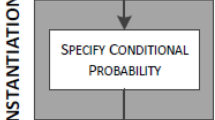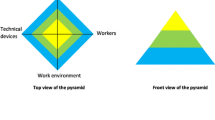Abstract
Following the principles of systemic accident models, in this paper we presented a new framework for modeling organizational aspect of hierarchical safety control structure in complex Socio-Technical Systems. In fact, we introduced a Specific Organizational Feedback Control Loop together with a Customized Process Model to narrow down System Theoretic Process Analysis (STPA) risk analysis method. Clearly, this modification can be able to adjust STPA for deficiency analysis of organizational safety control structure. As a case study, we used this framework in an aircraft maintenance industry, as a sample system. Indeed, we modeled and analyzed this system’s organizational safety control structure by our new framework. We demonstrated that, the new framework, as a modified version of STPA, can accurately model and analyze the organizational control mechanisms.












Similar content being viewed by others
References
Coze JCL (2005) Are organisations too complex to be integrated in technical risk assessment and current safety auditing? Saf Sci 43(8):613–638
Dehghan Nejad A (2015) Effect analysis of organizational safety control structure on aircraft reliability in maintenance industry (M.Sc. Dissertation, Shahid Beheshti University of Medical Sciences)
Dehghan Nejad A, Gholam Niya R, Alibabaee A (2016) The crisis of risk analysis in complex socio-technical systems a literature review Part A: dependency between common risk analysis methods and obsolete accident models. IOH 13(4):62–72
Dong A (2012) Application of CAST and STPA to Railroad safety in China (Doctoral Dissertation, Massachusetts Institute of Technology)
Drury CG (1991). Errors in aviation maintenance: taxonomy and control. In: Proceedings of the Human Factors and Ergonomics Society annual meeting, vol 35, no 2. SAGE Publications, pp 42–46
Drury CG, Prabhu P, Gramopadhye A (1990). Task analysis of aircraft inspection activities: methods and findings. In: Proceedings of the Human Factors and Ergonomics Society Annual meeting ,vol 34, no 16. SAGE Publications, pp 1181–1185
Dulac, N. (2007) A framework for dynamic safety and risk management modeling in complex engineering systems (Doctoral Dissertation, Massachusetts Institute of Technology)
Holnagle E (2010) From failure to emergence. SINTEF report A14732
IRGC (2010), The emergence of risks: contributing factors, report of international risk governance council, Geneva, ISBN 978-2-9700672-7-6
Ishimatsu T, Leveson N, Fleming C, Katahira M, Miyamoto Y, Nakao H (2011) Multiple controller contributions to hazards. In: 5th IAASS Conference, Versailles, France
Kazaras K, Kirytopoulos K, Rentizelas A (2012) Introducing the STAMP method in road tunnel safety assessment. Saf Sci 50(9):1806–1817
Khanzode VV, Maiti J, Ray PK (2012) Occupational injury and accident research: a comprehensive review. Saf Sci 50(5):1355–1367
Khawaji IA (2012) Developing system-based leading indicators for proactive risk management in the chemical processing industry (Doctoral Dissertation, Massachusetts Institute of Technology)
Kontogiannis T, Malakis S (2012) Recursive modeling of loss of control in human and organizational processes: a systemic model for accident analysis. Accid Anal Prev 48:303–316
Lampe M, Strassner M, Fleisch E (2004) A ubiquitous computing environment for aircraft maintenance. In: Proceedings of the 2004 ACM symposium on applied computing, ACM, pp 1586–1592
Leveson N (2004a) Model-based analysis of socio-technical risk
Leveson N (2004b) A new accident model for engineering safer systems. Saf Sci 42(4):237–270
Leveson N (2011) Engineering a safer world: systems thinking applied to safety. Mit Press, Cambridge
Loganathan MK, Gandhi MS, Gandhi OP (2015) Functional cause analysis of complex manufacturing systems using structure. Proc IMechE Part B J Eng Manuf 229(3):533–545
Marx DA, Graeber RC (1994) Human errors in aircraft maintenance. Aviation psychology in practice (A 96-10209 01-53). Avebury Technical, Aldershot, pp 87–104
Marx DA, Westphal JE (2008) Socio-technical probabilistic risk assessment: its application to aviation maintenance. Int J Aviat Psychol 18(1):51–60
McDonald N, Corrigan S, Daly C, Cromie S (2000) Safety management systems and safety culture in aircraft maintenance organisations. Saf Sci 34(1):151–176
Nakao H, Katahira M, Miyamoto Y, Leveson N (2011) Safety guided design of crew return vehicle in concept design phase using STAMP/STPA. In: Proceedings of the 5: th IAASS Conference, pp 497–501
Pelegrín L (2012) Integrating Safety into an Engineering Contractor’s System Engineering process using the guidelines of STAMP (M.Sc. Dissertation, Heriot-Watt University)
Phillips EH (1994) Focus on accident prevention key to future airline safety. Aviation Week & Space Technology
Qureshi Z (2008) A review of accident modelling approaches for complex critical socio technical systems. Defense Science and Technology Organisation
Rasmussen J (1997) Risk management in a dynamic society: a modelling problem. Saf Sci 27(2):183–213
Reason J (2016) Managing the risks of organizational accidents. Routledge, London
Samadi J (2012) Development of a systemic risk management approach for CO2 capture, transport and storage projects (Doctoral Dissertation, Ecole Nationale Supérieure des Mines de Paris)
Schönbeck M, Rausand M, Rouvroye J (2010) Human and organisational factors in the operational phase of safety instrumented systems: a new approach. Saf Sci 48(3):310–318
Skjerve AB, Albrechtsen E, Tveiten CK (2008) Defined situations of hazard and accident related to integrated operations on the norwegian continental shelf
Stringfellow MV (2010) Accident analysis and hazard analysis for human and organizational factors (Doctoral Dissertation, Massachusetts Institute of Technology)
Teng B (2010) Assessing risk and prevent accidents in complex system
Turner BA, Pidgeon NF (1997) Man-made disasters, vol 2. Butterworth-Heinemann, Oxford
Author information
Authors and Affiliations
Corresponding author
Appendices
Appendix 1: Model terminology
Communication Mechanisms a process—or set of processes—that has been set up to communicate specific information among two or more related component in control structure.
Feedback Control Loop is specific and organized communication mechanisms that allows for self-correction of system by providing appropriate tools for integral enforcement of safety constraint.
Organizational Feedback Control Loops The specific feedback control loop that all of its communication channels are a type of organizational mechanism like forms, procedure and etc. additionally, the controller of the loop is organizational component like organizational units, teams and etc.
Control Actions Control Actions are the action that is enforced by control components in hierarchical safety control structure to control of system behavior. Clearly, enforcement of Control Action is the main mission of control components.
Process Model Every controller must contain a model of the process being controlled. This model is Process Model. Whether the model is embedded in the control logic of an automated controller or in the mental model maintained by a human controller, it must contain the same type of information: the required relationship among the system variables (the control laws), the current state (the current values of the system variables), and the ways the process can change state. This model is used to determine what control actions are needed, and it is updated through various forms of feedback.
Organizational Control Mechanisms an organizational process—or set of processes—that has been set up to control specific system by use of Organizational Feedback Control Loops.
Mental Process Models model of the process being controlled that is embedded in mind of a human controller that has base role in organizational control components.
Hazardous Control Action the probable control components’ action that because of any dysfunctionalities could cause violation in safety constraints.
Hazardous System Behavior the probable behavior of the system—as a whole—that may cause to entrance of it to hazardous state.
Necessary Sensing Mechanism is a set of organizational mechanisms that are necessary for:
-
achievement of required information among under control process;
-
determination of what control actions are needed; and.
-
revising process model.
Sensor Mechanism organizational communication channels for transfer of required information to control component.
Interior Analytical Mechanism specific Analytical Mechanism for process of received information to determine appropriate Control Action by control component. This Analytical Mechanism is performed and handled by control component of the loop.
Exterior Analytical Mechanism specific Analytical Mechanism that is needed for processing of information to determine appropriate Control Action. But this Analytical Mechanism is performed and handled by another components of control structures if is requested by control component of the loop.
Request-Receive Mechanisms specific organizational mechanisms for receiving necessary information from other analytical components, if the use of Exterior Analytical Mechanism is needed for processing received information. These mechanisms prepare appropriate context for information exchange between interior and Exterior Analytical Mechanisms.
Analytical Process Loop consist of interior and/or Exterior Analytical Mechanisms together with Request-Receive Mechanisms.
Information Request Mechanism specific organizational communication channels that are used by control component for requesting analytical process from other components. These mechanisms are a part of Analytical Process Loop.
Information Receive Mechanism specific organizational communication channels that are used by control component for receiving analytical process from other components. These mechanisms are a part of Analytical Process Loop.
Non-Control Actions The actions that are performed by control component as an analytical process; for converting received information to appropriate control action.
Actuator Mechanism organizational communication channels for enforcing Control Action to under control process.
Appendix 2. Case study data
Rights and permissions
About this article
Cite this article
Dehghan Nejad, A., Gholamnia, R. & Alibabaee, A. A new framework to model and analyze organizational aspect of safety control structure. Int J Syst Assur Eng Manag 8 (Suppl 2), 1008–1025 (2017). https://doi.org/10.1007/s13198-016-0561-9
Received:
Revised:
Published:
Issue Date:
DOI: https://doi.org/10.1007/s13198-016-0561-9




